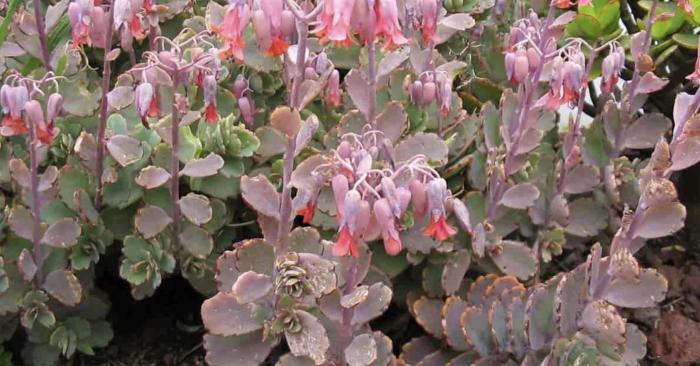Kalanchoe fedtschenkoi
Lavender Scallops

Description
Kalanchoe fedtschenkoi is a low-growing perennial succulent with pretty flowers and compact foliage. The name of the plant honors botanist Boris Fedtschenkoi and is now known as Bryophyllum fedtschenkoi. Native to Madagascar, the plant belongs to the Crassulaceae family of plants and the genus Bryophyllum. Since its introduction to North America, it’s established itself in parts of the southern United States. It’s a relatively easy succulent to grow as a houseplant and it makes a great ground cover in suitable climates. You may hear it called by its common name including: Lavender Scallops Kalanchoe Stonecrop South American Air Plant Gray Sedum Variegated Lavender Scallops Kalanchoe fedtschenkoi ‘Variegata’ is a short, shrubby succulent typically reaching 1? – 2? feet tall. It features stems which spread out from the root along the ground, forming large colonies of thick succulent leaves. The blue-green leaves have cream-colored variegation along scalloped edges. The edges may turn red or pink under strong sunlight or drought conditions. The fleshy foliage is often darker green toward the center and trimmed with lavender. Each leaf may reach up to 2? inches and feature two to eight teeth around the edges. The stems are smooth and bendable. When the stems reach the ground, they may take root and grow new plants. In the late spring to early summer, the plant produces small bell-shaped flowers. The flowers hang loosely from upright stems. The loose clusters of flowers are often reddish-brown and only reach about 3/4-inch in size. Each flower has a short calyx and a slightly longer corolla. The plant is winter hardy in (USDA Zones) hardiness zone 9b or warmer. Outside of these areas, it’s typically grown indoors as a houseplant. It can tolerate temperatures below freezing for short periods. If temperatures regularly drop below 25° degrees Fahrenheit (-4° C), bring it indoors for the winter. The plant needs lots of strong sunlight (preferably full sun), whether grown indoors or outside, especially during the summer. Use porous soil with fast drainage to help prevent over-watering and mold growth. To make regular potting soil more porous, add sand or perlite. Lavender scallops require transplanting every few years. Transplanting allows you to replace the old soil with fresh soil and move up to a larger pot if necessary. When repotting, use caution around the leaves. The leaves are a little brittle and may snap when handled. When grown inside, place it near a south-facing or west-facing window.
Plant Type
Perennial, Succulent
Height Range
1-3'
Width Range
Flower Color
Red
Flower Season
Spring, Summer
Leaf Color
Blue Green, Pink, Red, White, Variegated
Bark Color
n/a
Fruit Color
n/a
Fruit Season
n/a
Sun
Full
Water
Low
Growth Rate
Moderate
Soil Type
Sandy, Loam
Soil Condition
Well-drained, Dry
Soil pH
Neutral
Adverse Factors
n/a
Design Styles
Meadow, Mediterranean, Spanish, Wild Garden
Accenting Features
Showy Flowers, Unusual Foliage
Seasonal Interest
Spring, Summer
Location Uses
Entry, Perennial Border, Patio, Walkways, With Rocks
Special Uses
Container, Filler, Mass Planting
Attracts Wildlife
n/a
Water Saving Tip:
Dig-up patches of weeds and undesirable grasses from turf areas.
Use water to grow the turf you want, not the weeds you don't want! Once you have eliminated what you don't want, add sod or over-seed to repair the bare areas.